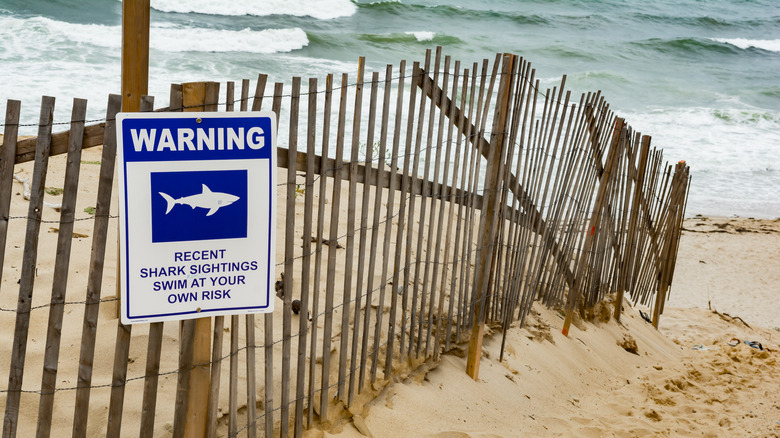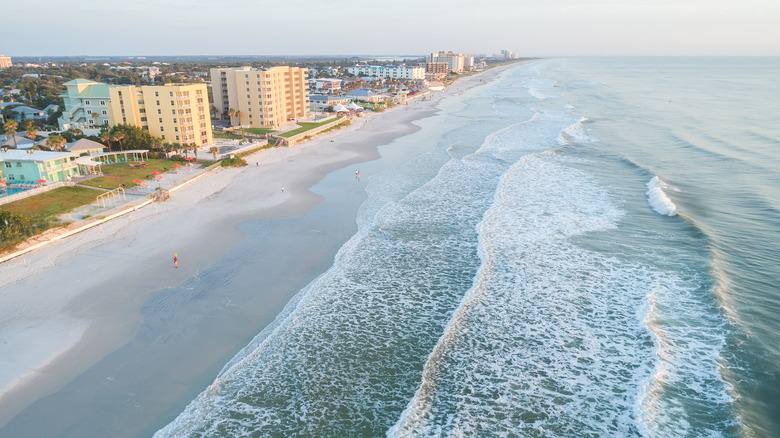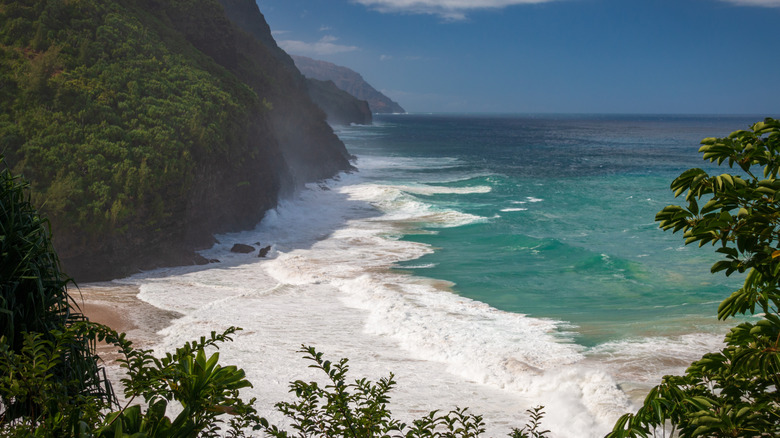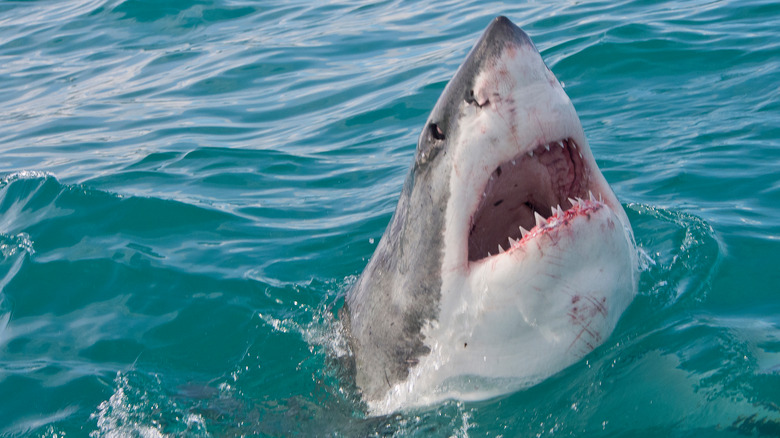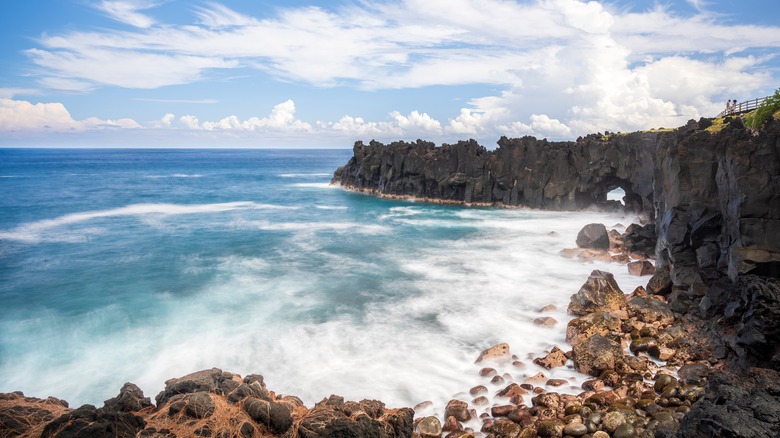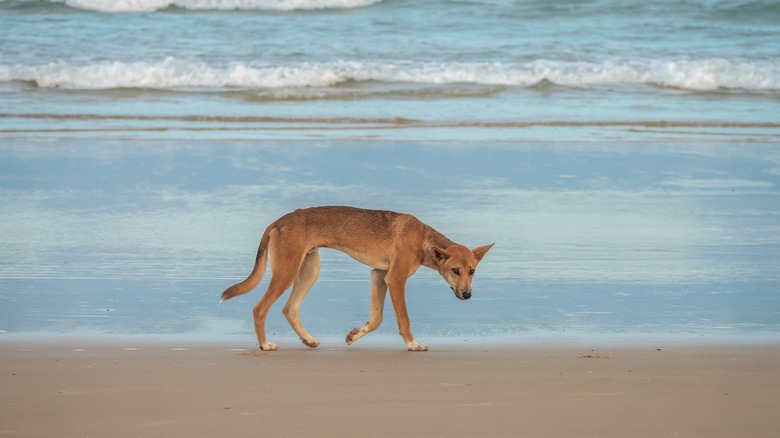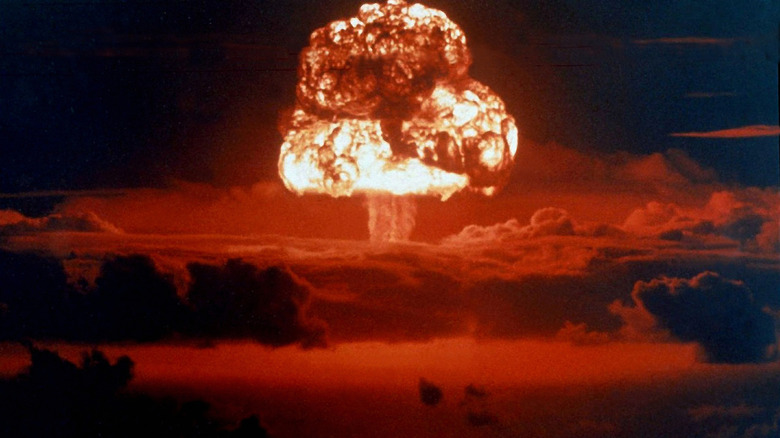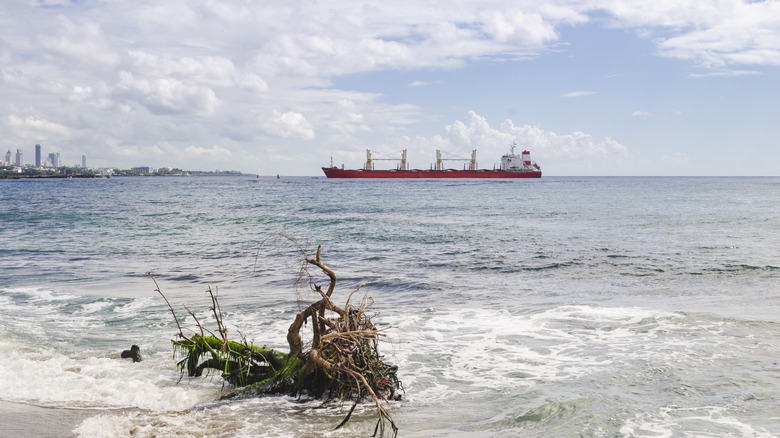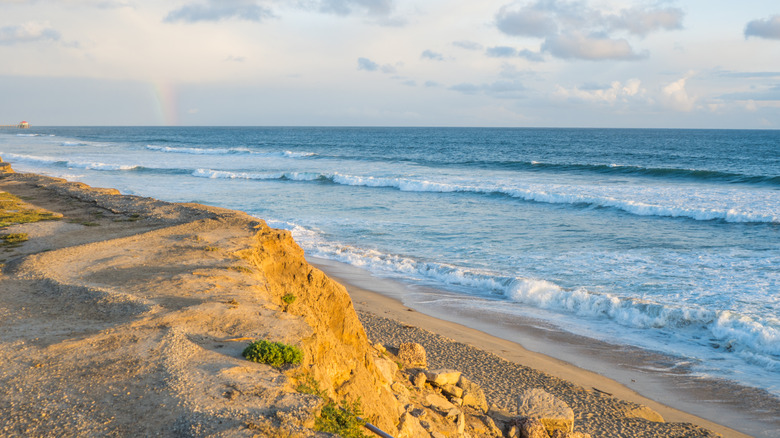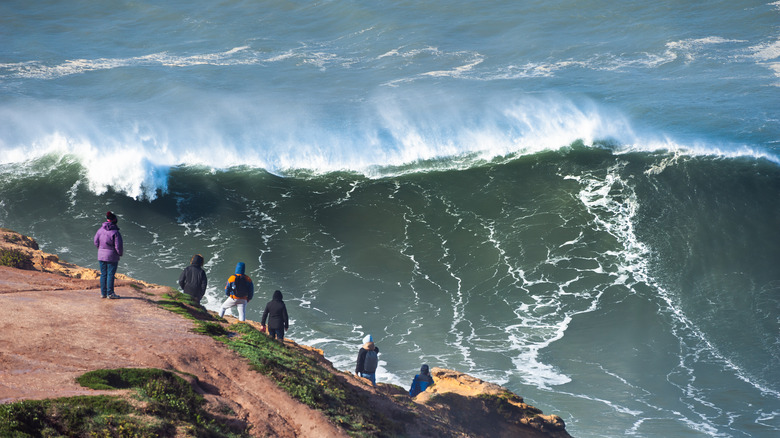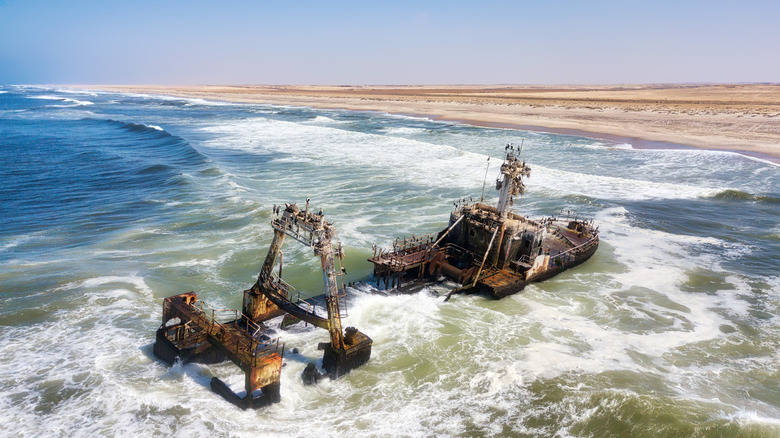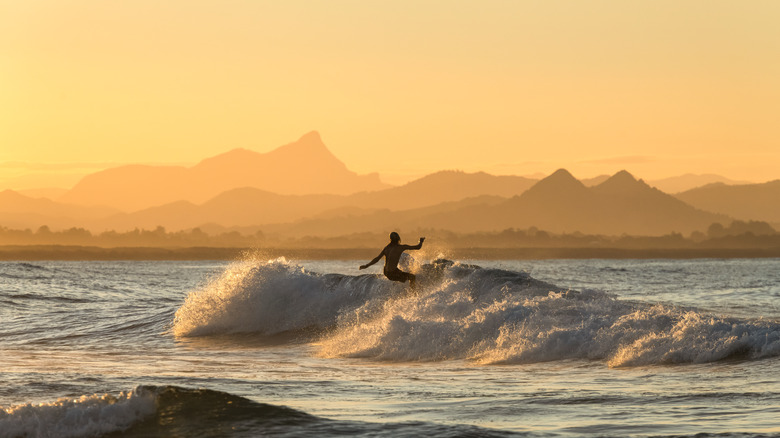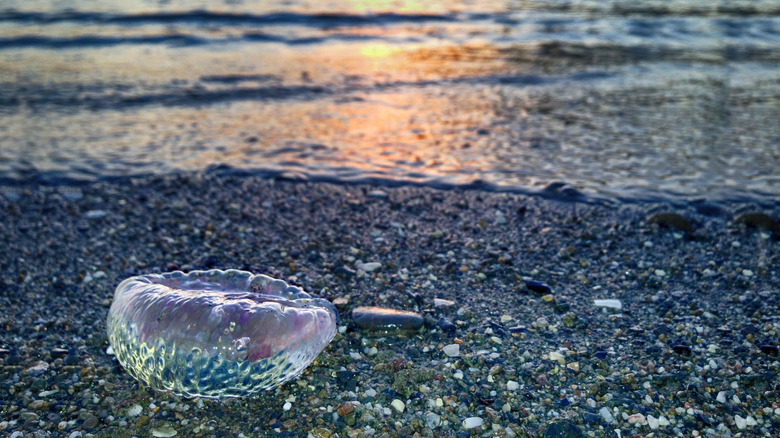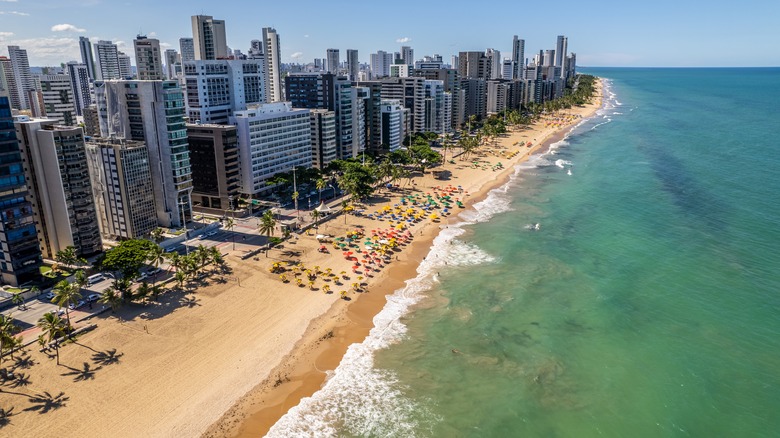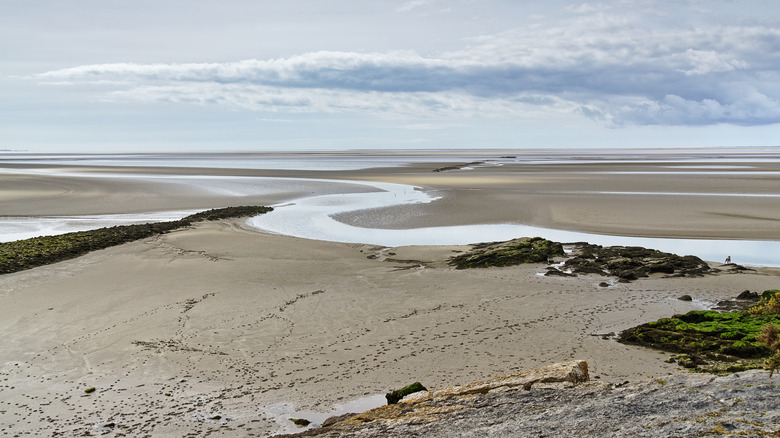14 Of The World's Most Dangerous Places To Swim
Not all beaches are created equal. There are some waters you are better off avoiding, let alone swimming in them. Sometimes beyond the tropical, white sand idyll, the turquoise waters conceal great white sharks lurking under the surface. Or a strong rip current may be especially fierce around certain places. Don't forget about the waters so radioactive that taking a dip may be life-threatening (Bikini Atoll). Or the beaches plagued by tons of stingy jellyfish during certain months of the year (Malaga). Or the sandy stretches where venomous vipers can bite you out of the blue (Bolsa Chica State Beach).
While some places like Skeleton Coast in Namibia are rarely visited by tourists, there are some popular beaches you may not have known are particularly hazardous (like New Smyrna Beach in Florida). In any case, let's take a fascinating journey to the globe's deadliest waters.
New Smyrna Beach, Florida
A gem of the Space Coast, New Smyrna Beach looks like a Caribbean dream with its endless dunes, surfing-friendly waves, and perpetual sunshine. It's also the "Shark Bite Capital of the World." With 94 unprovoked shark attacks since 2012 and 351 in total, according to the International Shark Attack File, Volusia County firmly holds first place among the most shark-infested waters in the U.S. While the majority of bites are non-fatal, it's still not a pleasant experience. What can be more dreadful than expecting underwater predators to get you?
This doesn't stop surfers, though. It seems like the dangerous reputation just sparks more interest in riding the waves. Competitions are held regularly, there are countless online guides on surfing in New Smyrna Beach, and the town has a well-established surfing culture. Haunting stats don't seem to work in this case, as surfers are drawn to the ideal waves of Volusia County. Not even the sharks can stop them. But you may not want to risk it in New Smyrna. Florida has a plethora of other beaches where shark attacks were never recorded. Go there.
Hanakapiai Beach, Hawaii
Some beautiful corners of our planet are best observed from a distance. That's the case of paradise-looking Hanakapiai Beach set on the Nā Pali Coast of Kauai. It's among Hawaii's most dangerous places to swim. The first thing you encounter when hiking to this place is the macabre, wooden death tally board indicating the number of people that drowned in the local waters. The numbers are tragic, as the ocean has taken the lives of more than 80 people since the 1980s here. Thus, taking a dip at this beach is much more dangerous than visiting any shark-infested beach.
The hazard comes from the powerful rip currents combined with the unpredictability of the high surf. Hanakapiai is also a remote place with no lifeguards around, so you will be one-on-one with the raging ocean. And the ocean rarely loses. Even if you're an experienced swimmer or a seasoned surfer, taking chances with the sheer power of Hanakapiai is unwise. Kauai and Hawaii boast plenty of magnificent beaches for swimming. Hanakapiai is not one of them.
Gansbaai, South Africa
When the coast is famous primarily for cage shark diving, you know that swimming there may come with submerged dangers. Gansbaai is notorious for having some of the most treacherous waters in South Africa due to the large numbers of great white sharks inhabiting the ocean here. Although their population is decreasing, the whole coast of South Africa is prone to shark attacks, which are often fatal. Recently, the BBC reported that the beaches around Cape Town have seen an increase in great white shark activity. The country is trying to solve its underwater predator problem by installing special preventive structures and nets.
When it comes to such off-the-radar spots as Gansbaai, you are looking at wilder beaches where swimmers are largely alone with the ocean and no lifeguards or help is immediately available. While meeting sharks from the comfort of a diving cage is a more or less safe way to swim in Gansbaai, we would advise you to stay clear of the coastal waters otherwise.
Réunion Island, France
While Réunion may be among the most enchanting Indian Ocean islands, it's also a place with a high frequency of shark attacks. The issue is so pressing that the incidents even influence local politics and harm tourism. The island has seen total bans on swimming due to sharks several times in its history (the most recent in 2021) and is under the constant stress of being in a "shark crisis". According to the BBC, the stats here are grim with a big part of shark attacks being fatal (out of 24 attacks between 2011 to 2019, 11 resulted in death).
Thus, visiting this stunning French overseas territory in the Indian Ocean comes with a big dilemma. On the one hand, you should absolutely come here for the epic volcanic mountains, diverse nature, and the abundance of outdoor activities. But exercise extra caution when getting into the water. If you're taking a dip, make sure that the beach has lifeguards and there are no bans in place. Réunion is called a "shark highway" for a reason, so don't underestimate the danger.
K'gari Island, Australia
K'gari (also known as Fraser Island) is an untouched, UNESCO-protected sandy paradise just off the Queensland coast. And while the gorgeous, long beaches may call to your surfing and swimming desires, take a dip elsewhere, as K'gari is among the most dangerous places in Australia to swim. Here, it's not one, but a whole package of dangers you should be aware of. Dingoes is the first one. These orange-colored, wild dogs populate the local sands. The emphasis here is on the "wild," as dingoes may sense danger from humans and attack (although, they rarely do this unprovoked). That being said, it's still better to enjoy your beach experience without a chance of being mauled by wild dogs.
But that's not all. The deadliest spider in Australia, the K'gari funnel-web spider, also calls Fraser Island home. Venomous snakes are here, too. And that's just on land. The eastern beaches of K'gari have recently made headlines for deadly great white shark attacks, and there's always a risk of getting sucked into a strong rip current. While you may be able to enjoy the wild beauty of Fraser Island cautiously, you may want to steer clear of the beaches and ocean here — it's not a welcoming place.
Bikini Atoll, Republic of the Marshall Islands
Don't be deceived by the adorable name. Bikini Atoll holds a special place on the list of the most dangerous islands in the world. Because rarely do you find beaches that endured 23 nuclear explosions. A blissful coral reef in the Marshall Islands, this place was the U.S. testing site from 1946 and 1958 and a veritable hell on Earth. Bizarrely, it also donned its name to the famed two-piece swimsuit that Louis Réard introduced in Paris on July 5, 1946.
You would want to avoid wearing yours on Bikini Atoll, though. It's a radioactive wasteland disguised as a tropical dream. The coral reef is contaminated by the radioactive material called Cesium-137, with some parts of the atoll producing 639 millirems per year (with a safety standard of no more than 100). According to UNESCO, the force of nuclear bombing here was 7,000 times the power of the Hiroshima bomb. While scuba diving activities are now open to visitors, you still risk long-term, radiation-related health problems. Avoid Bikini Atoll, please.
Haina Beach, Dominican Republic
While the Dominican Republic is famous for its white, gorgeous beaches, Haina is not one of them. Having an unflattering nickname "Dominican Chernobyl," this beach has one of the worst cases of lead pollution in the world. The levels of contamination are so high that it's estimated that almost everyone in the community is exposed to lead poisoning. Haina is a sad story of environmental neglect, mismanagement, and irresponsible industrial behavior. It's the last spot where you would want to swim on this idyllic Caribbean island.
The town of Bajos de Haina is the biggest electricity provider on the island. It's also a hotspot for metallurgy as well as the chemical and pharmaceutical industry. Factories dump waste into the waters, the fumes make breathing unbearable, and dangerous materials are leaking into the soil. And while there is a local beach called Playa Gringo, you should absolutely avoid it and go to the picture-perfect coast of Punta Cana.
Bolsa Chica, California
Southern California is a land of cinematic sunsets, great surf, and magnificent beaches. It's also home to venomous yellow-bellied sea snakes that occasionally make an appearance. Move over sharks, how about an underwater reptile with deadly poison? That's a big nope. As the ocean temperatures rise, more and more sea snakes are "arriving" in California. Currently, the sightings are still quite rare, but each year, it seems like there's a higher chance of an encounter.
Bolsa Chica is among the Southern Californian beaches where the yellow-bellied snakes have been spotted. These creatures are not the only ones you should be worried about, though. Along with snakes in Bolsa Chica State Beach, you'll also need to be aware of Southern Pacific rattlesnakes, scorpions, and black widow spiders. That doesn't mean that you should avoid the beach. Just know about the risks beforehand and observe the recommendations of the National Park Service, and you'll be fine. Hopefully, you won't meet any deadly sea snakes.
North Beach, Portugal
What can be a more breathtaking visualization of the force of nature than an 86-foot wave crashing into the coast? Praia do Norte (or North Beach) in Nazaré along Portugal's western coast is where you find such spectacle. But it's one thing to observe the show safely from the Farol viewpoint; it's a whole different kind of danger when you are in the epicenter of the action. While for some, like the record-breaking surfer Sebastian Steudtner who tamed the biggest wave ever surfed in 2020, it may be doable; for others, it's a sure way to die.
As tempting as it is for extreme surfers to try Nazaré, North Beach is an extremely challenging swimming spot. The waves reach such heights because of a geographical feature called a submarine canyon, an abyss 16,404 feet deep that makes the surf more powerful as the water travels into the coast. The local news is filled with stories about people drowning and suffering near-death experiences due to the strong currents and unpredictable wave behavior. Sometimes it's better to just observe, which fully applies to almost everyone visiting North Beach.
Skeleton Coast, Namibia
It's all in the name. Looking like a backdrop for a post-apocalyptic movie, the eerie Skeleton Coast in Namibia's northern part is a desolate, unfriendly place. While gorgeous in its end-of-the-world glory, you don't want to come here for swimming purposes. Hundreds of shipwrecks are left rotting among its sands, the bare bones of whales dot the "Dune"-like landscape, and the winds blow ceaselessly. It's a no man's land where enigmatic desert lions roam and you may suddenly hear the laughter of hyenas cackling.
Today, the area is a part of a vast Skeleton Coast National Park, and there are tour operators that organize desert safaris, surfing outings, kayaking trips, and 4x4 adventures. Due to the powerful currents and constant winds, swimming is out of the question here. Once you're in the water, the strong grip of the ocean will take you miles and miles away, and you risk sharing the fate of the bones ultimately devoured by local sands.
Byron Bay, Australia
Australia may be heaven on Earth for surfers. But there are beaches where you may feel uneasy staring at the black depths of the water. Factually speaking, the most dangerous place to swim in the country is Byron Bay, sometimes referred to as the "Shark Attack Capital of Australia." And while the nickname may feel a bit sensational, statistics don't lie. Twenty-seven attacks have happened in Byron Bay in the last 30 years, three with deadly consequences (the last one being in 2020). Also, New South Wales, where Byron Bay is located, experiences the most incidents in Australia, according to the International Shark Attack File.
But again, that's statistically speaking. Byron Bay is among the most charming places in New South Wales, boasting miles and miles of stunning beaches, an atmosphere of adventure in the air, and a very developed surfing culture. You'll probably be fine chasing the waves here, but the chances of a shark encounter remain nonetheless, even though locals tend to shrug off the issue.
Málaga Beaches, Spain
It's not only too much alcohol and tapas that can harm your health on the golden beaches of Costa del Sol in Spain. Year after year, the Málaga coast deals with a "jellyfish invasion." No one is surprised when the authorities take out tons of these marine animals from the waters, while hundreds of people seek medical attention for the stings. The danger here may not be equivalent to great white sharks or strong rip currents, but the scale of the problem is bigger and affects more people. Málaga beaches are visited by hundreds of thousands yearly, as it's one of the most popular destinations in Southern Europe.
July and August are the top months for jellyfish to appear. Pelagia noctiluca, a small, mushroom-shaped transparent medusa, is the main intruder. While the sting of this marine creature doesn't lead to anything more than a burning sensation, it may be dangerous for vulnerable populations. There's one species that you don't want to encounter under any circumstances, though. The Portuguese Man-O-War is a poisonous, faux-jellyfish organism that can be extremely dangerous to humans.
Boa Viagem Beach, Brazil
When looking at Boa Viagem Beach in the northeastern city of Recife, you wouldn't think of it as particularly dangerous. The skyscrapers tower above the boardwalk that borders the long, sandy stretch. Brazilian Miami is the first thing that comes to mind. But Boa Viagem is also considered to be the most shark-infested beach in the country, an unflattering title the locale has received from statistics. This area experienced 40% of all the shark attacks in Brazil recorded between 1992 and 2023, with 28 fatal incidents.
Scientists are still trying to understand why this particular part of the Brazilian coast attracts such deadly attention from two species, namely tiger and bull sharks. The prevalence of fatal incidents was dubbed an "anomaly." And while the secret to attacks remains unsolved, it's best not to go in the water in Boa Viagem. While swimming is permitted during the low tide, surfing is officially prohibited.
Morecambe Bay, U.K.
Sometimes dangers lurk where you least expect them. That's the case of Morecambe Bay in the U.K., which can sometimes be a deadly place. The main perils here come from the swiftly shifting tides that can leave a person trapped in the mud and devoured by the quicksand. The area was also the site of a tragedy called the Morecambe Bay cockling disaster that occurred in 2004 when 21 undocumented Chinese migrants perished in the sands while harvesting cockles. The accident shook the U.K. at the time and highlighted the hidden dangers of the unpredictable tidal flats estuary.
Although the quicksand and the changing tides are widely publicized and the authorities do their best to emphasize the dangers of Morecambe Bay, there are always people who disregard the official warnings and get stuck in the sands. But let's be honest, you don't want to swim near deadly quicksand. If you want to learn more about Morecambe Bay, you can join one of the hiking tours organized in the area.
